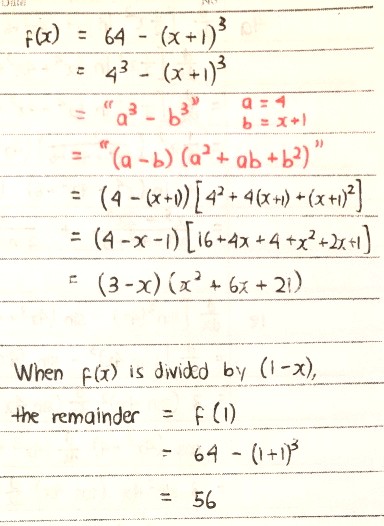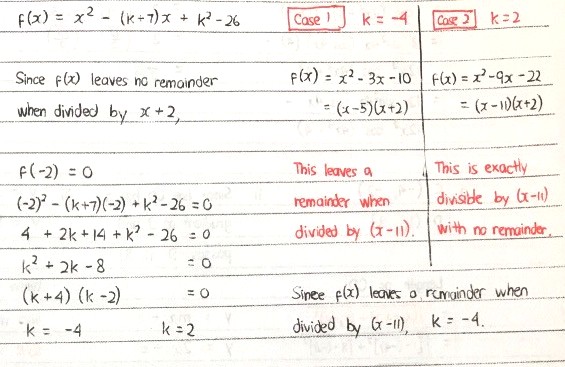Ask Singapore Homework?
Upload a photo of a Singapore homework and someone will email you the solution for free.

See 2 Answers
done
{{ upvoteCount }} Upvotes
clear
{{ downvoteCount * -1 }} Downvotes
Part a
Date Posted:
4 years ago
The factorisation of a3 - b3 is (a - b) (a2 + ab + b2).
So we call a3 - b3 the expanded form and (a - b) (a2 + ab + b2) the factorised form.
So in this case,
64 - (x + 1)^3 is considered the “expanded form” and
[4 - (x + 1)] [4^2 + 4 (x + 1) + (x + 1)^2] the “factorised form”.
Having said that, leaving the second bracket just like that is considered not simplified, so we must tidy up the second term by expanding its contents and leaving our answer as ax2 + bx + c.
It’s a matter of judgement to see whether an expression is considered “simplified” or not.
Things like x^2 - 1 are not considered simplified because they are not factorised, but things like (x + 3)^2 + 2 (x - 4) + 7 are also not considered simplified.
So we call a3 - b3 the expanded form and (a - b) (a2 + ab + b2) the factorised form.
So in this case,
64 - (x + 1)^3 is considered the “expanded form” and
[4 - (x + 1)] [4^2 + 4 (x + 1) + (x + 1)^2] the “factorised form”.
Having said that, leaving the second bracket just like that is considered not simplified, so we must tidy up the second term by expanding its contents and leaving our answer as ax2 + bx + c.
It’s a matter of judgement to see whether an expression is considered “simplified” or not.
Things like x^2 - 1 are not considered simplified because they are not factorised, but things like (x + 3)^2 + 2 (x - 4) + 7 are also not considered simplified.
done
{{ upvoteCount }} Upvotes
clear
{{ downvoteCount * -1 }} Downvotes
Second one
Date Posted:
4 years ago
how did u get the eqn to sub in for case 1 n case 2?
When we solve with the condition “exactly divisible by x + 2”, we would be substituting x = -2 into f(x). The remainder f (-2) will equal to 0, and we solve this equation to find the value of k. Or rather, “values” as it turns out.
There are two values of k, and we substitute these values of k back into the f(x) equation (I cut short the steps by one line).
From there, we use the second condition to determine which value of k to reject and which one to accept. Only one value of k will fit the second condition that x - 11 is not a factor (since a remainder exists upon division with x - 11).
There is no need to do the remainder theorem for the second condition as the resulting quadratic expression for each value of k can be easily factorised, bearing in mind that x + 2 must be one of the factors.
There are two values of k, and we substitute these values of k back into the f(x) equation (I cut short the steps by one line).
From there, we use the second condition to determine which value of k to reject and which one to accept. Only one value of k will fit the second condition that x - 11 is not a factor (since a remainder exists upon division with x - 11).
There is no need to do the remainder theorem for the second condition as the resulting quadratic expression for each value of k can be easily factorised, bearing in mind that x + 2 must be one of the factors.
but both of the eqn gives out (x+2), and the qn said (x+2) is exacrly divisible. and when the ans is (x-11)(x+2) thr isnt any remainder from what i understand. why isit that when the ans is (x-5)(x+2) there is a remainder? when it is also fully factorised??
Of course, both equations must contain the (x + 2) factor because we obtain the expressions for f(x) from this clue.
Now, to clarify for the k = -4 case,
f(x) = x2 - 3x - 10
= (x - 5) (x + 2)
We can see from the factorised form itself that (x - 11) is not present (only the (x - 5) and (x + 2) is inside), so there will be remainder upon division with (x - 11).
We can continue using the remainder theorem to show that there will be a remainder, that is,
f (11)
= (11 - 5) (11 + 2)
= (6) (13)
= 78
so the remainder is 78, or non-zero.
Instead, for the k = 2 case,
f (x) = x2 - 9x - 22
= (x - 11) (x + 2)
We can see from the factorised form itself that (x - 11) is clearly present, so (x - 11) is a factor of f(x). Think of it this way. 8 = 2 x 4, so 2 is a factor of 8.
Since (x - 11) is a factor in this case, the remainder would be zero.
Using the remainder theorem to further support my argument, we have
f (11)
= (11 - 11) (11 + 2)
= (0) (13)
= 0
so there is no remainder.
Of course, the question provides the extra information that there will be a remainder upon division with (x - 11), so it has to be the case that k = -4.
Now, to clarify for the k = -4 case,
f(x) = x2 - 3x - 10
= (x - 5) (x + 2)
We can see from the factorised form itself that (x - 11) is not present (only the (x - 5) and (x + 2) is inside), so there will be remainder upon division with (x - 11).
We can continue using the remainder theorem to show that there will be a remainder, that is,
f (11)
= (11 - 5) (11 + 2)
= (6) (13)
= 78
so the remainder is 78, or non-zero.
Instead, for the k = 2 case,
f (x) = x2 - 9x - 22
= (x - 11) (x + 2)
We can see from the factorised form itself that (x - 11) is clearly present, so (x - 11) is a factor of f(x). Think of it this way. 8 = 2 x 4, so 2 is a factor of 8.
Since (x - 11) is a factor in this case, the remainder would be zero.
Using the remainder theorem to further support my argument, we have
f (11)
= (11 - 11) (11 + 2)
= (0) (13)
= 0
so there is no remainder.
Of course, the question provides the extra information that there will be a remainder upon division with (x - 11), so it has to be the case that k = -4.
We do not actually need to factorise the quadratic expression to be able to find the remainder.
We can even substitute x = 11 straight into the equations.
First case, k = -4
f(x) = x2 - 3x - 10
f(11) = 11^2 - 3 (11) - 10 = 78
And the other one will be the k = 2 case.
f(x) = x2 - 9x - 22
f(11) = 11^2 - 9 (11) - 22 = 0
So we can immediately tell that the k = -4 case will give a remainder.
We can even substitute x = 11 straight into the equations.
First case, k = -4
f(x) = x2 - 3x - 10
f(11) = 11^2 - 3 (11) - 10 = 78
And the other one will be the k = 2 case.
f(x) = x2 - 9x - 22
f(11) = 11^2 - 9 (11) - 22 = 0
So we can immediately tell that the k = -4 case will give a remainder.
so i can jst writr f(11) and find out from the 2 new eqns?
Yup! We can just substitute it straight away.
Factorising the expressions is just an alternative method to this (they are in fact related).
Factorising the expressions is just an alternative method to this (they are in fact related).
thanks alot for your patience in teaching :')






